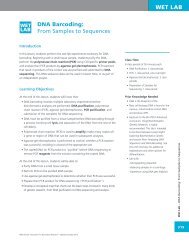LESSON 4 Using Bioinformatics to Analyze Protein Sequences
LESSON 4 Using Bioinformatics to Analyze Protein Sequences
LESSON 4 Using Bioinformatics to Analyze Protein Sequences
You also want an ePaper? Increase the reach of your titles
YUMPU automatically turns print PDFs into web optimized ePapers that Google loves.
<strong>LESSON</strong> 422. Show Slide #10, which is the same codon table as in Slide #8. Walkstudents through the example of the start codon AUG, encouraging them <strong>to</strong>follow along on Student Handout—Codons and Amino Acid Chemistry. Clickthe space bar or forward arrow <strong>to</strong> advance the animation. A gray arrow willappear for each step.• Step 1: Start in the center of the table, in the “A” quadrant for the firstposition of the codon.• Step 2: From the A quadrant, move <strong>to</strong> the next outer ring and locate the“U” slice for the second position of the codon.• Step 3: From the U slice, move <strong>to</strong> the third ring outward <strong>to</strong> the thirdposition of the codon in the “G” slice.• Step 4: From the G slice, move <strong>to</strong> the outermost ring and locate theamino acid that corresponds <strong>to</strong> it – in this case methionine (M), which iscolored yellow because it is nonpolar/hydrophobic, also indicated by the“N” on the codon table.<strong>Bioinformatics</strong> & <strong>Protein</strong>s: Slide #1023. Importance of Side Chains:Explain <strong>to</strong> students that amino acids are often characterized by genetic researchersbased on the chemistry of their side chains or R-groups. When mutations changethe coding sequence and replace one amino acid with one that has differentchemical properties, the function of the protein can be reduced, or the proteinmay not function at all. This is called a non-conservative change. For example,some proteins are held <strong>to</strong>gether when the side chains of positive and negativeamino acids are attracted <strong>to</strong> each other. If a negatively-charged amino acid were<strong>to</strong> be replaced with a positively-charged amino acid, the interaction would belost, and the protein may not hold its shape anymore. When mutations changethe coding sequence and replace one amino acid with one that has the samechemical properties, this is called a conservative change.24. Methionine:Tell students that methionine, like the other amino acids colored yellow onthe table, is hydrophobic (also called nonpolar, and noted with an “N” on thecodon table). This means that these amino acids do not like water, or repelwater. In proteins, these amino acids are often buried in the center <strong>to</strong> theprotein, away from water.Non-conservative: When amino acidchanges observed between two or moresequences do not share the same sidechain or R-group chemistry.Conservative: When amino acidchanges observed between two or moresequences do share the same side chainor R-group chemistry.[Note: During the Bio-ITEST Introduc<strong>to</strong>ryunit, <strong>Using</strong> <strong>Bioinformatics</strong>: GeneticTesting, the M1775R mutation studentslearned about in the BRCA1 proteinchanged the amino acid chemistry froma hydrophobic methionine (M) <strong>to</strong> apositively-charged arginine (R) at aminoacid position #1775.]Lesson 4 – <strong>Using</strong> <strong>Bioinformatics</strong> <strong>to</strong> <strong>Analyze</strong> <strong>Protein</strong> <strong>Sequences</strong>129©Northwest Association for Biomedical Research—Updated Oc<strong>to</strong>ber 2012
















